
What is a Recomp? Body Recomposition Explained
Recomp is short for body recomposition, which is when you build muscle and lose fat at the same time. It’s the holy grail of the fitness industry. It’s actually pretty common, though, especially among people who are out of shape or new to lifting weights.
Let’s go over some examples and some research, and explain how to do it.
Recomping from Weight Training
Most weight training studies put people on a workout program without trying to encourage weight gain or weight loss. The training stimulates muscle growth, but building muscle takes energy, and they aren’t eating extra energy. So, their bodies are forced to get energy from their body fat, causing body recomposition.
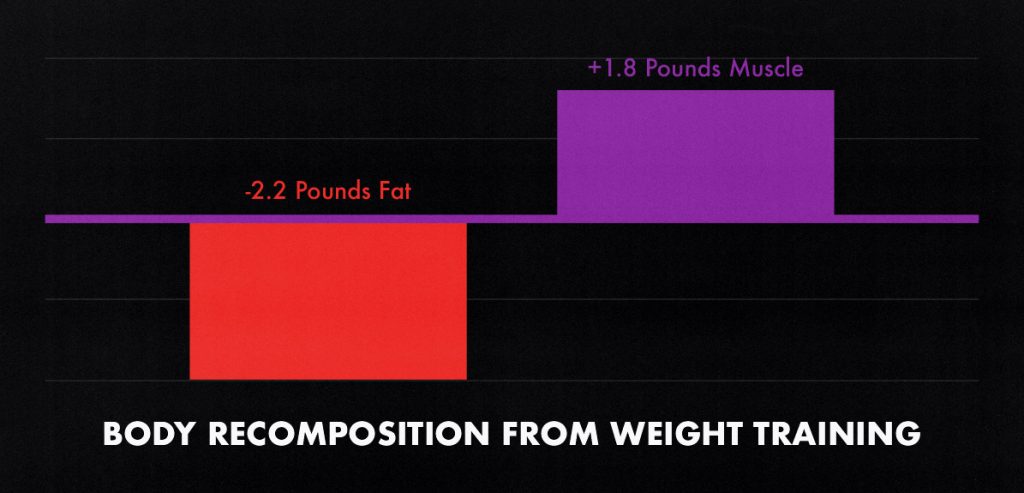
The best data comes from a recent meta-analysis of 116 studies (study). On average, working out for 4 months caused people to lose about 2 pounds of fat while gaining 2 pounds of muscle.
You can probably do better than that. The type of training designed to stimulate muscle growth is called hypertrophy training. If you follow a good hypertrophy training program, I wouldn’t be surprised if you get even more body recomposition.
What if You Eat More Protein & Fewer Calories?
The most important part of recomping is hypertrophy training. That’s what stimulates muscle growth, encouraging your body to use the energy from your fat to build muscle. But what if we look at a classic cutting protocol, where the participants lift weights, lose weight, and eat more protein?
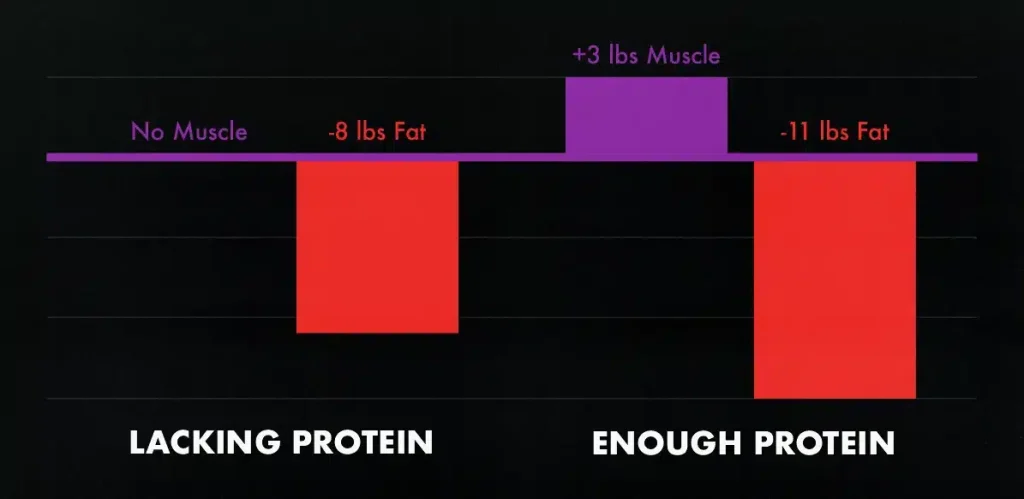
Longland and colleagues put participants on a hypertrophy training program and told them to eat in a calorie deficit (study). Half of the participants ate an average amount of protein (about 0.5 grams per pound of body weight per day), and the other half ate twice as much (1 gram/pound/day).
After one month, both groups had lost about 8 pounds of weight. The group eating a normal amount of protein lost 8 pounds of fat. The group eating more protein lost 11 pounds of fat while gaining 3 pounds of muscle, achieving body recomposition.
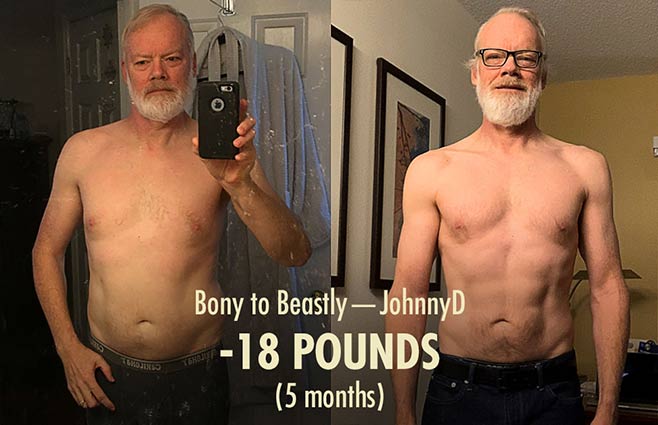
We see this with skinny-fat and overweight clients sometimes. They lose weight, gain strength, and finish with bigger muscles than when they started. In the more obvious cases, they finish with smaller waist circumferences, broader shoulders, and bigger arms.
What If You Eat More Carbs & Calories?
Protein is arguably the most important nutrient for recomping, but what if we look at a classic bulking protocol, where people eat more carbs to drive themselves into a calorie surplus?
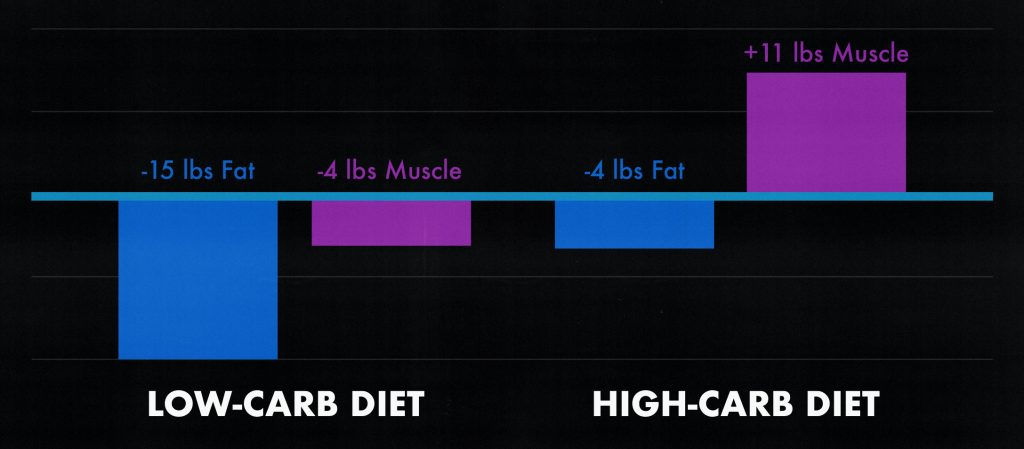
Kruszewski and colleagues took intermediate lifters and put them on either a low-carb or high-carb diet while following a hypertrophy training program (study).
The low-carb diet wasn’t very filling, causing the participants to lose quite a bit of weight. The study shows that they lost muscle mass, but some of the mass in our muscles comes from carbs (glycogen). When you eat fewer carbs, your muscles lose some of that glycogen, which can cause a few pounds of temporary muscle loss. The muscle will come back when you start eating more calories and carbs.
The higher-calorie, higher-carb group managed to recomp. After four months, they’d gained 11 pounds of muscle while losing 4 pounds of fat. Eating more calories and carbs supports more muscle growth. Plus, their muscles probably inflated with a pound or two of glycogen.

Older studies have gotten similar results from high-carb, high-calorie diets. For example, Rozenek and colleagues gave a bunch of new lifters mass gainers full of thousands of calories of carbs (study). After 8 weeks, they’d gained 7.5 pounds of muscle while losing half a pound of fat.
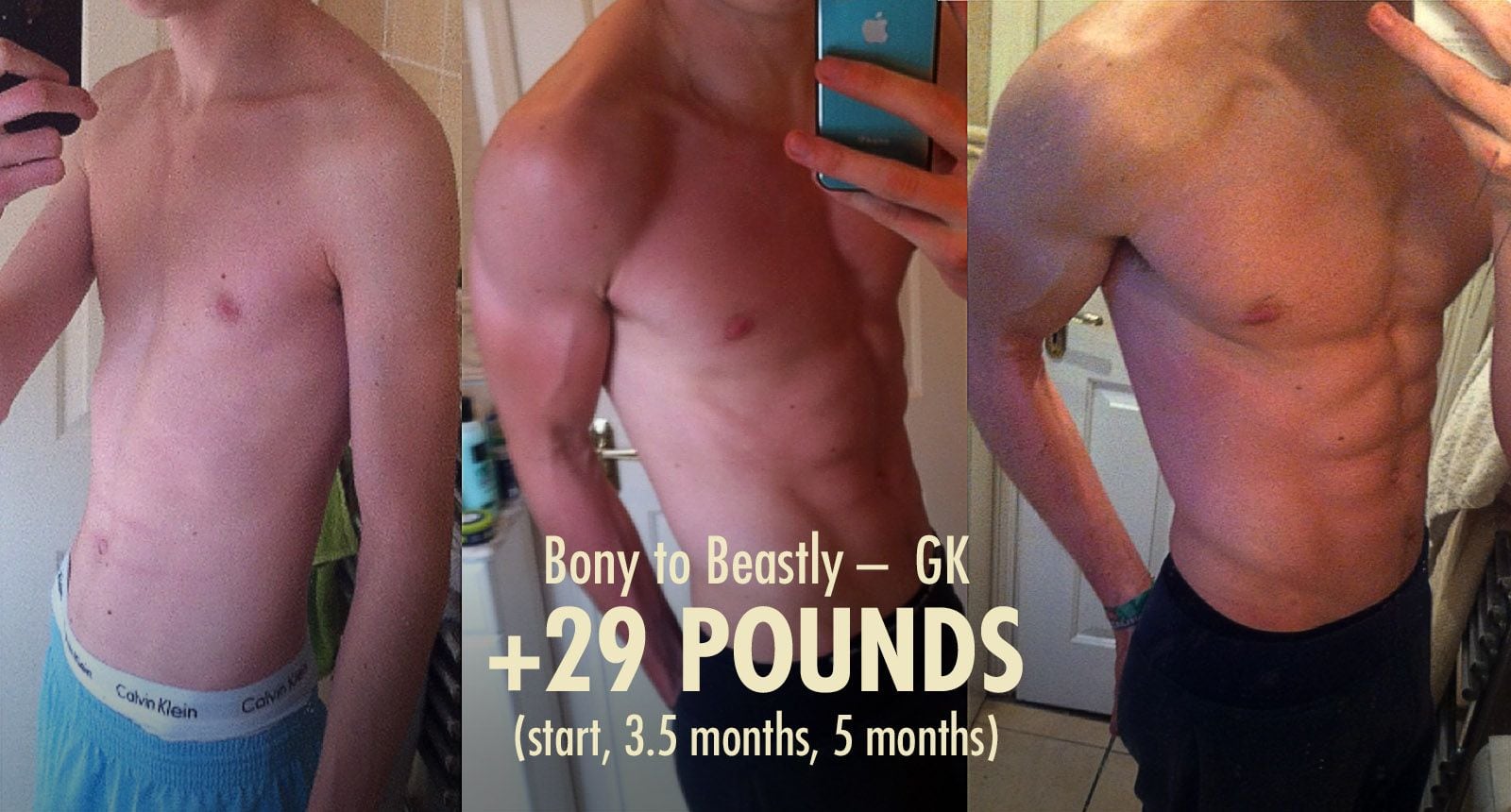
We see that with skinny clients sometimes. They bulk pretty aggressively and still manage to lose fat. I had similar results during my first bulk when I first started lifting weights and eating a good muscle-building diet.
What If You Get Better Sleep?
Getting better sleep gives you more energy, greater self-control, stronger hormone production, and an enhanced ability to build muscle. When you combine it with a good weight training routine, it can help you recomp.

Jabekk and colleagues split the participants into two groups (study). Both groups were put on a hypertrophy training program. Only one group was given some tips about how to improve their sleep. We cover all those methods in our article on sleep.
After 10 weeks, the participants who combined weight training with better sleep lost 4 pounds of fat while gaining 4 pounds of muscle, achieving body recomposition.
What if You Bulk and Cut?
The trouble with recomping is that it doesn’t work forever. It makes for a great place to start, but eventually, your body won’t want to burn more fat to build more muscle. It will settle into a new point of equilibrium. At that point, you’ll need to pull out the big guns. You’ll need to choose between:
- Eating more calories to keep gaining muscle and strength.
- Eating fewer calories to keep burning fat.
If your waist circumference at the height of your belly button is 40 inches or more, gearing into a calorie deficit will probably be better for your general health. Otherwise, both options are great, and focusing on building muscle often makes for a good next step.
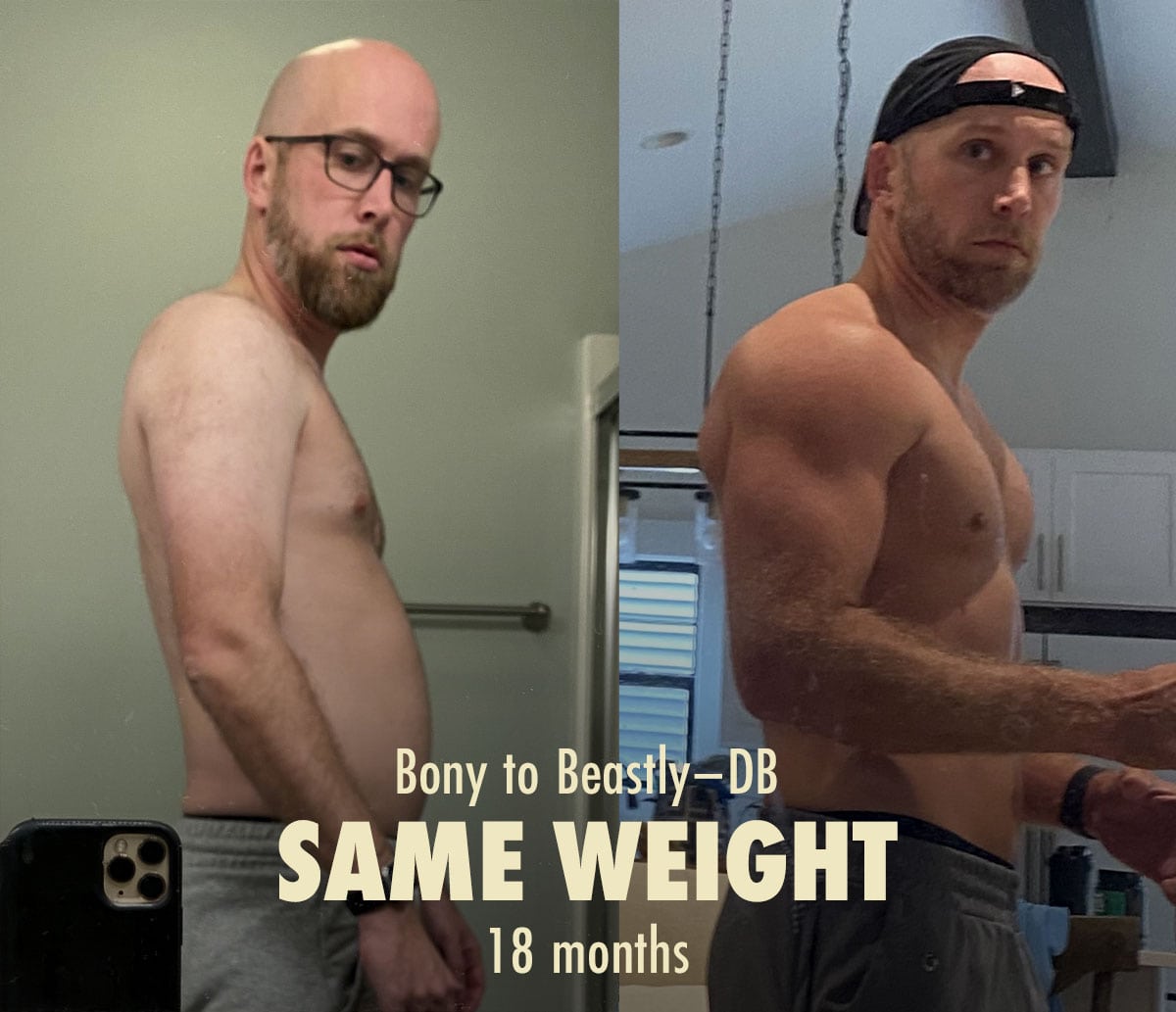
I recommend doing a lean bulk for at least 3 months, but ideally closer to 6. That way, you have time to gain a significant amount of muscle. After that, could spend 2–3 months trimming off fat, finishing both bigger and leaner than when you started. It’s a recomp on a longer timescale. For more, we have a full article on bulking and cutting.
How to Recomp
The best way to recomp is to combine all of the interventions that encourage muscle growth and/or fat loss. Here they are in order of importance:
- Lift for muscle growth (hypertrophy training): I recommend starting with full-body workouts and doing 1–2 exercises per muscle group, 3–5 sets per exercise, 6–20 reps per set, and lifting to the brink of failure.
- Eat enough protein: I recommend eating 0.7–1 gram of protein per pound of body weight per day. Eat more protein if you’re older, leaner, losing weight, or eating a vegan diet.
- Eat enough carbs: I recommend eating at least 2–3 grams of carbs per pound of body weight per day if you can. Less is fine, more is better.
- Eat a nutritious diet: you don’t need to eat a perfectly “clean” diet, but do try to eat balanced meals made from nutritious foods. Fruits, veggies, nuts, seeds, legumes, fermented dairy, fatty fish, lean meat, and so on.
- Get enough good sleep: I recommend getting in bed at least 8 hours before any alarm goes off. You might not need all 8 hours. Plenty of people do fine with 7. But that way, you aren’t woken prematurely. If stress prevents you from falling asleep, try something relaxing and distracting, such as reading a fiction novel under a dim light.
- Eat according to your appetite at first: You can calculate your calories here, but you don’t have to. You can start your recomp by eating a comfortable amount of food. Your appetite should keep your weight reasonably stable.
- Add/remove calories when you hit a plateau. The easiest way to recognize a plateau is to track your strength gains in the gym. When you stop making progress on most exercises most workouts, you probably aren’t recomping anymore, so it’s time to be more deliberate with your calorie intake. (If you want to track your calories, here’s our review of the best calorie-tracking app.)

If you want a customizable workout program (and full guide) that builds on these principles, check out our Bony to Beastly (men’s) program and Bony to Bombshell (women’s) program. Or, if you’ve already gained your first 20–30 pounds, check out our Outlift Intermediate Hypertrophy Program.
Shane Duquette is the co-founder of Outlift, Bony to Beastly, and Bony to Bombshell. He's a certified conditioning coach with a degree in design from York University in Toronto, Canada. He's personally gained 70 pounds and has over a decade of experience helping over 10,000 skinny people bulk up.



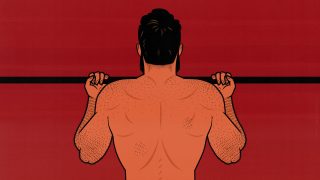
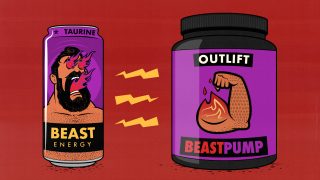
I’ve done a few cycles of cutting and bulking over the past 18 months, through b2B and Outlify for the last year or so. My weight now is right where it was when I started (173 lbs). I have improved my strength and body composition, though, quite a bit. I’ve also learned a lot about the power of calorie manipulation and using the scale for feedback.
I’m at a stage where I’d prefer for my body weight to not have to fluctuate so much if I can avoid it. Since I’m happy with my weight (BMI 23.5) recomping is an attractive option. I’m just not sure it’s the best option for me. Building muscle and getting leaner remain my goals and right now they’re about equally important to me.
I am getting a Dexascan for the first time next week. Do you think the results of that scan should impact whether I decide to recomp or continue with bulking and cutting? Or are there better data points to base this decision on?
Hey Darren, that’s great! Nice job.
Yeah, recomp might not be the best option for you. It works best for people who are newer to lifting weights and/or have more fat to lose. But there’s only one way to find out. You could train and eat for muscle growth, but instead of manipulating your calories, you’d eat according to your appetite. See if you can gain steadily gain strength. A program like Outlift is perfect for that. If you’re making progress, that’s a great sign you’re recomping.
If you aren’t making progress in your workouts, you might need to eat in a slight calorie surplus to build more muscle. You can eat in a very slight calorie surplus, though. That way you’re building muscle as leanly as possible, without large fluctuations in weight. After a few months of that (i.e. an entire program), you could consider switching to a slow cut, if you want.
But you can start by trying a proper recomp.
DEXA is one of the best and most interesting ways to measure your body composition. You’ll get a ton of cool data about your muscle, bone, and fat. I don’t think it will help you figure out whether to bulk, cut, or recomp, though. You may very well learn that your body composition is great, and you don’t need to do anything.
If you wanted to track your fat gain from a health perspective, you could measure your waist circumference (and try to keep it under 36 inches). If you wanted to factor in muscle, the Navy Method is pretty good. It adds a couple of measurements. That article explains it.
Thanks, Shane! Your responses are second to none.
I’ll try the recomp as you suggest and see how it goes. I think I’ll keep getting stronger. I was able to get a little stronger while slowly cutting from 180 to 173 over the past 4 months. Starting to eat at maintenance/appetite should only improve my lifts.
Jeff Nippard seems to think that most lifters, even fairly experienced ones – which I definitely am not – can recomp effectively EVEN WHILE their calories are slightly above or below maintenance. That was a bit shocking to hear. I’m guessing that means that if I find myself gaining a few pounds while my waistline stays the same, I’m recomping in a surplus. Conversely, if I find myself losing a few pounds while continuing to get stronger, I’m probably recomping in a deficit. Either way would be fine with me. I would start to get concerned if my waistline jumped up (it’s at 35” now) or if my strength plummeted. Then I’d probably intervene by manipulating my calorie intake more intentionally. Does that sound right to you?
Yeah, that’s a great sign. If you were gaining strength while cutting, I bet you were recomping then, too. Now we’ll just be shifting the recomp a bit more towards muscle growth.
I disagree with Jeff Nippard on that. I’m more in line with another expert he often quotes, Dr. Eric Helms. It’s certainly possible for some people to recomp in a deficit, at maintenance, or in a calorie surplus at some points in their training career, but it can also be difficult and unreliable, and as you get more experienced, it gets harder. Fortunately, if you do a good job of tracking your progress, then you’ll know when it’s working and when it isn’t. It IS working for you, so it makes sense to milk it for as long as you can.
I think I may also have bad recomp genetics. I’ve never been able to do it. I haven’t ever been able to gain muscle size or strength at maintenance. I’m not complaining, though. I respond well to a calorie surplus, so it hasn’t ever been a problem.
Recomping math is a little tricky. A pound of fat contains about 3,500 calories of stored energy. A pound of muscle takes about 2,500 calories to build. So if you lose 5 pounds of fat and build 5 pounds of muscle while recomping, your weight will be the same, but you’ve burned 17,500 calories and used 12,500 calories, putting you in a 5,000 calorie deficit. You can even gain a bit of weight while being in a small calorie deficit. But your point is correct.
Yep! That’s right. Keep recomping for as long as you’re still gaining strength. When you stop gaining strength, you can gear into a cut to burn fat while you keep maintaining your strength, or you could gear into a lean bulk to gain strength while keeping the fat at bay.
Interesting how you can gain weight in a deficit but makes sense with that fancy math.
My DEXA scan came back at 24.4% body fat. Thats after a successful bulk and cut! All the more reason, I think, to recomp. I should have plenty of fat to fuel muscle growth. I wonder if you, Shane, haven’t been able to recomp because you’ve never been skinny fat?
I was hoping for a leaner result, but maybe this works in my favor. I’m not unhappy with my body as it is now despite it being far from optimized. The DEXA people recommended I aim for 16% by gaining 7 pounds of lean muscle and losing 13 pounds of fat. That sounds like a good target.
I’ll test again in 6 months and assess how effectively recomping is helping my hit that target.
Yeah, I think that’s it. I’ve always been naturally thin, with a tendency to undereat. I don’t think my body has ever been interested in burning scarce body fat to build costly muscle. Your situation is much different.
That’s a great plan! Just make sure to strive for steady weekly progress, too. You want to be seeing steady strength gains in the gym, adding weight and reps on your exercises over time. Gaining strength is a great sign of gaining muscle, and if you aren’t gaining weight, then it’s a great sign of body recomposition.
Good luck, and let me know how it goes!
Hi Shane,
I think it is obvious that a 6foot two and a 32inch waist like in your case recomp is not going to work. I think you are even for a skinny guy some kind of outliner. 🙂
Best regards
Sebastian
Yeah, I was unusually skinny for sure.
Hi Shane,
Thank you for all of the very helpful content, you have no idea how helpful these articles are. I had a quick question regarding whether a recomp would be the best move for me.
For context, I used to weigh ~180 lbs 7 months ago at 5’10 with very minimal muscle mass. I went on a cut prioritizing cardio (which in hindsight might have been a mistake), occasionally lifting, and hitting my protein goals. I now weigh ~153lbs but still have significant fat in my belly area (~35 inch waist circumference) and still feel like I have a very similar physique as before (skinny-fat) despite losing some weight.
In this instance, would a recomp where I am in a slight caloric deficit to cut some more fat make sense? Or should I be in a slight surplus? Or should I leave behind calorie tracking entirely, just let my appetite guide me, and play it by ear? I feel like I’ve been trapped in this “skinny-fat” phase for years now!
Additionally, does the Bony to Beastly plan (or another offering) have content that is specific/relevant to a skinny fat physique, or is it more geared to other body types? Apologies for the lengthy comment. Thank you again.
My pleasure, Andy!
Congratulations on losing those 27 pounds!
If you went from being sedentary to doing cardio while cutting, that’s great. Cardio will have preserved some muscle, and I bet you got MUCH fitter and healthier. It would have been even better to mix some lifting in there to preserve/build muscle, but that’s alright. Plenty of time for that now.
If you lose SOME fat, then the fat covering your muscles gets smaller, but your muscles are still hidden. It’s only when you get quite lean that you carve out muscle definition. I need to make an illustration of this. It’s really helpful to see.
If you build muscle, it adds shape beneath your fat, giving you a buff look even at higher body-fat percentages. But it isn’t realistic to build THAT much muscle while cutting. That’s usually the sort of shape you build while bulking. That’s why if you build enough muscle while bulking, you can look quite a bit stronger and more muscular, even if you gain some fat. (In your case, though, since you have a history of being over-fat, you’d want to bulk slowly and leanly.)
That’s why you still look skinny fat. You aren’t quite lean enough for definition, and you aren’t quite strong enough for shape.
It sounds like you’re still new to lifting, right? In that case, recomping is realistic right now, yeah. Then, when you plateau, we can see whether it makes more sense to do a lean bulk or cut a little deeper. But it’d be good to recomp for as long as you can. It’s only when you stop making steady, measurable progress that you’d switch over.
Recomping is perfect for guys with skinny fat physiques! If you’re overweight, you need less weight, so cutting usually makes sense. If you’re underweight, you need more weight, so bulking usually makes sense. Weight isn’t your issue, so a recomp is ideal (for as long as it works).
Yep! Our flagship Bony to Beastly Program is for skinny AND skinny fat guys. It’s equally built for both. Our members are an even mix of both, too 🙂
Our other programs are best for after that, once you’ve got a good base of muscle and strength, once you’re good at lifting weights. Right now, Bony to Beastly would be perfect.
I hope you decide to join us!
Hi Shane,
Thank you so much for the response, it’s very helpful. I definitely do feel as if I am in much better shape. I really appreciate the color regarding how body fat can affect the optics of muscle/how it looks on your body.
For context, I’ve lifted in spurts over the last 1.5 years. I had a stretch of ~6 months lifting consistently (the first time in my life) where I saw gains in my lifts but my overall numbers are still very small, then a 6 month period of a very sedentary lifestyle (caused extensive weight gain) to this last ‘cutting’ period, bringing me to my current state now. Throughout all of those phases I was certainly skinny/skinny fat with low muscle mass.
Would this still classify me as relatively “new to lifting” to the point where a recomp would work effectively? And to follow up on the mechanics of that, should I just let my appetite purely guide me in terms of caloric intake?
Either way I’m likely going to give a recomp a shot for a bit (maybe 7-10 weeks) before deciding where I want to go from here, and will look more into Bony to Beastly as I’m sure it will be an invaluable tool.
Thanks again for all of your help and wonderful work.
My pleasure!
Yeah, I’d still say you’re fairly new to lifting. Good that you’ve got some practice, too.
I think a recomp would still work well. But you can track and see. In the short term, if you’re adding weight or reps to your lifts most weeks, gradually growing stronger, then that’s a great sign it’s working. In the medium term, you can look at your waist, arm, and shoulder measurements every 4–8 weeks. In the longer term, you can compare progress photos every few months.
Good luck over these next 7–10 weeks!